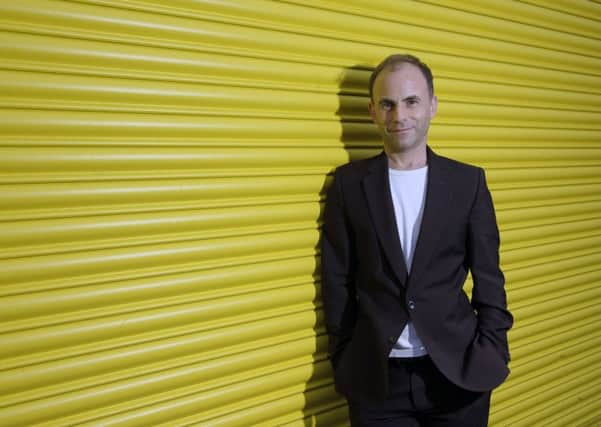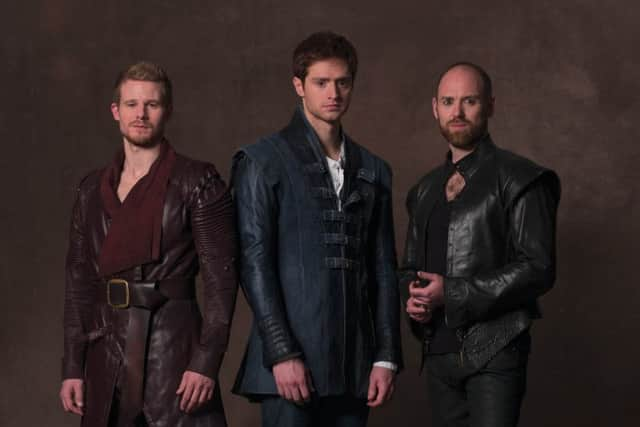Laurie Sansom pulls the strings in James Plays revival


WHEN The James Plays opened at the Edinburgh International Festival in 2014, it was Scottish theatre operating on a near-unprecedented scale. Rona Munro’s trilogy of Scottish history plays was brought to life by a 20-strong ensemble, with many more behind the scenes. The performances were made possible by support from EIF and the National Theatre in London, but many in Scotland who missed the two-week run were concerned that the budget would never be found to bring them back.
Now, 18 months on, the theatrical behemoth of The James Plays is back, playing in Edinburgh, Inverness, Glasgow, various venues in England, and at festivals in Adelaide and Auckland. National Theatre of Scotland artistic director Laurie Sansom, who directs the plays, said it had taken “quite a bit of time” to pull together the necessary resources, but he is excited to be revisiting the trilogy with an ensemble which includes half the original cast and ten new actors.
Advertisement
Hide Ad“It has enabled us to reassess them, reinvent them and keep them fresh,” he says. “Our understanding of the plays has grown, both Rona’s and mine, as different actors teach you different things about them.”


Audiences should expect a few changes this time round, including a new first act for James II – felt by some critics to be the weakest play of the three – and the absence of the puppet used to symbolise the child James in the original version. Says Sansom: “We wanted to challenge ourselves: if we take the puppet away, and the actor playing James II is having to live through all the trauma he goes through in his early life, do we feel more emotionally engaged with it? Is it a more satisfying story? We’ll see what happens, but I think it makes it much stronger.”
Key roles have had to be recast, including James I (Steven Miller) and his queen Joan (Rosemary Boyle), and James III (Matthew Pidgeon) and his queen, Margaret of Denmark (Swedish actress Malin Crépin, stepping into the shoes of The Killing’s Sofie Gråbøl). Sansom says he looked for actors who would bring themselves to the roles, rather than “carbon copies” of the last cast, and says they have brought out new dynamics in the relationships between characters. “The story remains the same, but you actually see it through a different prism if you have different leading actors. It’s a real pleasure to see the plays refracted through slightly different lenses.”
Neither Pidgeon nor Crépin saw the original production, and they say that has helped them create their own, fresh take on the relationship between James and Margaret. “We’ve been able to forge a new thing, the whole relationship is new with two new actors, and the play then becomes new as well,” says Pidgeon, who came to The James Plays straight from the Royal Shakespeare Company’s adaptation of Hilary Mantel’s Wolf Hall, another theatrical behemoth.
“In a way, I see it as a gift,” says Crépin, best known as crime reporter Annika Bengtzon in the eponymous Scandi noir film series. “I feel like they laid the ground for us, it’s more like a relay where we’ve picked up the baton. I’ve seen runs of the first two plays and I think it’s one of the best things I’ve seen on stage for years. I’m so proud to be part of it.”


Both actors praised the strength of the ensemble and say they appreciate the energy and encouragement of a large company. Crépin says it helps her with the language, although all evidence indicates she speaks English fluently, as well as Danish, Norwegian, French, German and Italian.
Advertisement
Hide AdThe very particular character of each of the plays will be preserved. Before the first production, Sansom likened James I to Game Of Thrones, James II to Pan’s Labyrinth, and James III to “a kind of All About Eve with Bette Davis”. Central to the drama in the latter is the relationship between James and Margaret, a passionate on-off love affair which endures despite James’ affairs with both men and women. It’s a time of relative prosperity for Scotland, which might be just as well because James has a penchant for crazy (and expensive) schemes and little interest in kingship.
“There is quite a bit in the first two plays about slaughtering your enemies,” says Pidgeon. “James is more interested in beauty, intellectual pursuits, artistic ideas, he doesn’t want to be in some muddy field fighting the English. He’s quite child-like, quite spoilt, he’ll fight to get everything he wants even if his wife and his parliament are telling him he can’t have them. He’s a very difficult, stubborn, temperamental man and he can be very cruel, but he can also be loving and funny, and he’s clearly in love with his wife. If I spend too long with him, it’s exhausting, but he’s a lot of fun to play.”
Advertisement
Hide Ad“And lot of fun to play with,” adds Crépin. “Always with James, you have to have something he wants, a fabric, or your body, or a cake – anything. It’s about handling him. They have a very interesting relationship, a very modern relationship. It’s a dysfunctional, abusive marriage in a way, but they really love each other despite everything.”
While James and Margaret maintain separate homes at Stirling and Edinburgh, they never truly separate. Pidgeon says: “It’s very moving, they can’t quite keep away from each other, because they’re deeply in love, despite all the fighting. At one point, he says, ‘Show me one being on this earth who loves me more than any other soul.’ Actually, the closest anyone comes to that is Margaret. They’ve known each other since they were kids.”
The journey in the play is as much Margaret’s as James’s. In the face of his continuing neglect of his kingly duties, and to prevent the sparring factions at court from starting a civil war between her husband and her eldest son, Margaret steps up to the job of ruling – and does it very well.
The dramatic turning point is the mirror – a rare and expensive thing in medieval Scotland – which reveals to both James and Margaret a true image of themselves (the play is subtitled The True Mirror). Pidgeon says: “It’s rather crushing for James, he sees an ageing man who’s not what he was, he’s obsessed with beauty and he sees himself crumbling. He brings it to Margaret because he wants her to be down in the pit of despair with him. But she sees a developed, mature woman and she’s excited by the power of that.” n
Twitter: @wordsmansfield
• The James Plays open at the Edinburgh Festival Theatre on Wednesday. www.nationaltheatrescotland.com